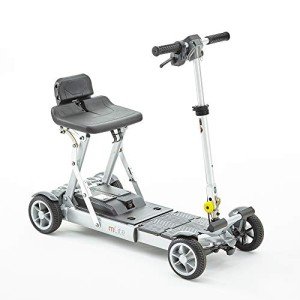8 Tips To Increase Your Mobility Devices Game
Understanding Mobility Devices: Enhancing Independence and Quality of Life
In today's busy world, the desire for mobility is universal. Nevertheless, certain medical conditions or age-related challenges can impede motion, leading to a continuous search for help. Mobility devices work as important tools to boost self-reliance, improve lifestyle, and make it possible for people to engage completely in their communities. This post provides a thorough overview of mobility devices, including their types, functions, choice criteria, and more.
Types of Mobility Devices
Mobility devices vary from simple aids to complicated equipment, customized to satisfy various requirements. Below is a table summarizing typical types of mobility devices:
Type of Device
Description
Perfect For
Walkers
Four-legged support devices that supply remarkable stability while walking.
People needing additional assistance.
Walking sticks
Single or three-legged sticks that improve balance and support walking.
Those with slight mobility difficulties.
Wheelchairs
Seats mounted on wheels, offered in handbook and electric variations.
People with limited or no mobility.
Scooters
Electric lorries created for outdoor use and ease of navigation.
Those who can't walk fars away.
Crutches
Devices that help people transfer weight away from an injured leg.
Individuals recuperating from leg injuries.
Rollators
Walkers with wheels, seats, and brakes for enhanced mobility.
Users requiring rest choices while walking.
Lift Chairs
Reclining chairs that help users in standing and taking a seat.
Seniors or those with mobility restrictions.
Mobility Scooters
Small electric cars for restricted mobility, typically utilized outdoors.
Individuals requiring help over fars away.
Key Features of Mobility Devices
When picking a mobility gadget, a number of key functions need to be considered to guarantee ideal functionality and ease of usage:
- Weight Capacity: Understanding the gadget's weight constraint is essential for security and efficiency.
- Adjustability: Devices ought to be adjustable in height and width to fit the user comfortably.
- Portability: Lightweight and foldable choices are important for users who travel or require transportation.
- Stability and Safety: Look for features like anti-tip wheels and tough structures to enhance security.
- Alleviate of Use: Simple systems and user-friendly designs can make a considerable distinction in daily use.
- Convenience: Ergonomic styles and padded seats can improve the user experience.
Picking the Right Mobility Device
Choosing the best mobility gadget can be an overwhelming task. Here are some actions to direct the decision-making procedure:
- Assess Needs: Evaluate the person's mobility challenges and daily activities.
- Seek advice from a Professional: Engage health care specialists who can offer suggestions based upon the person's physical condition.
- Trial Options: If possible, trial various devices to determine convenience and performance.
- Evaluation Budget: Consider the cost of the device, including any extra features or adjustments needed.
- Research Options: Determine the very best brands and models by reading reviews and comparisons.
Table: Comparative Analysis of Popular Mobility Devices
Device
Advantages
Disadvantages
Walkers
Outstanding stability, promotes walking.
Large, may limit motion in small spaces.
Walking sticks
Lightweight, boosts balance.
Might not provide enough support for severe mobility problems.
Wheelchairs
Suitable for those with substantial mobility limitations.
Can be troublesome, particularly in indoor environments.
Scooters
Great for outside usage, easy to maneuver.
Limited indoor use, heavier.
Rollators
Provides rest option, easy to move.
May require more space than conventional walkers.
Raise Chairs
Comfy, helps shift from sitting to standing.
More expensive, larger footprint.
Often Asked Questions (FAQs)
1. What is foldable scooters ?
A mobility device is any tool designed to assist individuals in moving and browsing their environment. This consists of walkers, wheelchairs, scooters, and crutches.
2. How do I understand which mobility device is best for me?
Consider your specific mobility challenges, physical capabilities, and way of life requirements. Consulting with health care professionals can also provide customized recommendations.
3. Are mobility devices covered by insurance?
Many insurance strategies, consisting of Medicare, might cover specific mobility devices. It's essential to examine with your insurance coverage supplier for particular protection details.
4. Can I lease a mobility gadget instead of buying one?
Yes, numerous medical supply stores and drug stores provide rentals for mobility devices. This choice is helpful for people with temporary mobility concerns.
5. How can I maintain my mobility device?
Regular maintenance is vital. It includes cleaning the gadget, checking for wear and tear, and ensuring all parts are working properly.
The Impact of Mobility Devices on Quality of Life
Mobility devices considerably enhance the quality of life for individuals with restricted mobility. They cultivate independence, encourage social interaction, and boost access to essential services and recreational activities.
- Increased Independence: Users can navigate their neighborhoods, participate in occasions, and take part in hobbies without relying on others.
- Social Engagement: Mobility devices assist in participation in celebrations, thus combating sensations of seclusion.
- Enhanced Safety: Devices supply stability and minimize the danger of falls, promoting user confidence.
Mobility devices are more than just tools for motion; they are gateways to self-reliance and quality living. By comprehending the different kinds of mobility aids readily available, their key functions, and considerations for picking the best device, individuals can make informed decisions about their mobility requires. Ultimately, the ideal mobility gadget can lead to a more active, satisfying life. Whether it's a walker, wheelchair, or scooter, the right choice contributes significantly to enhancing the mobility and self-reliance of users.
